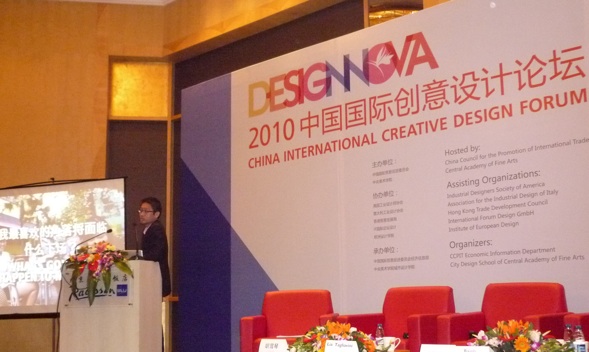Winston Ng, Associate Director for Greater China at Consulus, speaks at the China International Creative Design Forum
Just as nobody can really identify one beachfront from another just by looking at photographs alone, many emerging brands in Asia, particularly China, face a similar dilemma in trying to occupy a unique position and brand in the market. This was one of many central topics at the heart of the discussion at the China International Creative Design Forum (中国国际创意设计论坛) and Designnova 2010, organized by the China Council for the Promotion of International Trade (CCPIT) (中国国际贸易促进委员会) in Beijing’s Radisson Blu hotel on 14 November 2010.
Ng joins 150 people at the event, which includes academics and students from top design and arts universities, officials from the CCPIT and Hong Kong Trade Development Council, and design body and association presidents from the US, Italy and Hong Kong. Promising young designers were conferred various awards in recognition for their entries, while various industry, education and socio-economic trends and views were exchanged between the keynote presenters and audience.
While design bodies’ speakers shared facts and opinions about the history of design evolution in Italy, Germany and the US, other trade specialists showcased examples of visual and information communication in the Western markets.

Chinese university deans touched on the delicate issue of the future of design and design education in China, and how they should shape the economic development of the country. And while the Industrial Designers Society of America (IDSA) CEO, Clive Roux tried to narrow China’s role to providing design solutions for “bottom-of-pyramid” societal strata and developing economies, Chinese students and officials shared their desire to create their own identity in Chinese design mastery, and thus contribute to the world.
Ng brought the forum to a conclusion with a presentation focusing on the need to introduce socio-economic value to any design product, making the importance of staying relevant to the business environment by balancing client and designer expectations even clearer.
The classical design agency model, one that minimises business and economic value thinking, is now outdated as more multi-disciplinary talents offer solutions that go beyond aesthetic outcomes.
A case study, myVillage, was presented to show the intricacy between brand identity, communication strategies and stakeholder relationship dynamics. A coherent brand management system has to complement any form of visual or information design output, regardless of the type of product, service or organization involved.
myVillage, transformed from a sleepy neighborhood retail mall to a center of social activity for the resident population, was a successful effort by Consulus to develop a brand strategy in a holistic and effective manner. Brands looking to go global should look within to harness their inherent assets and advantages, and this holds true especially for rapidly emerging Chinese and other Asian brands.
Photo 1 & 3: Shandong Art & Design Academy





